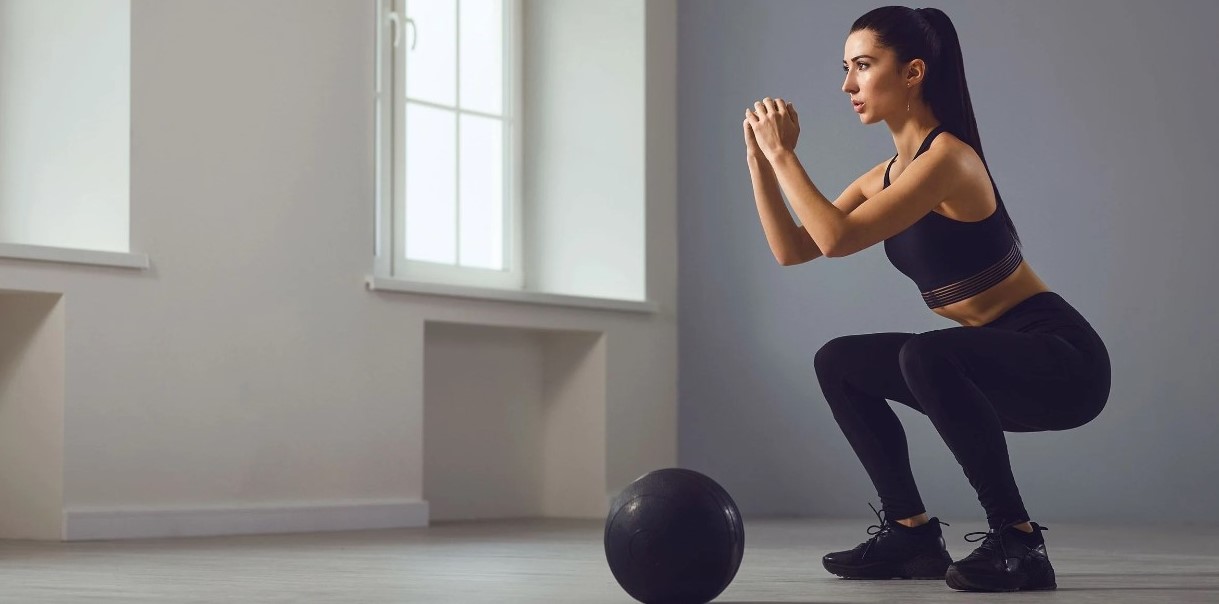Get Bootylicious with Squats
Do Squats Make Your Butt Bigger?
Get Bootylicious with Squats: Do Squats Make Your Butt Bigger? Discover the truth behind this popular exercise and learn how squats can help you achieve a fuller and more lifted butt. Find expert insights, FAQs, and useful tips in this comprehensive article.
If you're looking to achieve a sculpted and curvaceous backside, squats might be the answer you've been seeking. Squats are renowned for their ability to tone and strengthen the gluteal muscles, commonly known as the buttocks. However, does the much-talked-about squat exercise really make your butt bigger? In this in-depth article, we will explore the science behind squats and their impact on butt size. We'll also provide valuable tips, personal experiences, and expert advice to help you get bootylicious with squats!
Get Bootylicious with Squats: Do Squats Make Your Butt Bigger?
Squats have gained popularity as one of the most effective exercises for building gluteal muscles and shaping the buttocks. When performed correctly, squats engage multiple muscles in the lower body, including the quadriceps, hamstrings, and glutes. The gluteus maximus, the largest muscle in the buttocks, plays a significant role in the squat movement.
During a squat, the gluteus maximus contracts to lift the body back to a standing position. As you add resistance, such as using weights or resistance bands, the glutes work even harder to overcome the force, leading to muscle growth and development.
The Science Behind Squats and Glute Development
Squats trigger a process known as hypertrophy, wherein the muscle fibers undergo microscopic damage during exercise. As the muscles repair themselves, they become thicker and stronger, resulting in increased muscle size. The repeated stress and adaptation cycle is what leads to visible changes in the gluteal muscles over time.
Moreover, squats involve both concentric and eccentric muscle contractions. The lowering phase of a squat (eccentric contraction) causes more muscle fiber damage than the rising phase (concentric contraction). This emphasizes the importance of proper form and controlled movement during squats to maximize glute activation and growth.
Variations of Squats for Maximum Glute Engagement
While the standard bodyweight squat can provide significant benefits, incorporating variations of squats can target specific areas of the glutes for comprehensive development. Some effective squat variations include:
Sumo Squats: This wide-stance squat targets the inner thighs and glutes, emphasizing the gluteus medius, the muscle responsible for hip stabilization.
Bulgarian Split Squats: By placing one foot on an elevated surface behind you, this squat variation puts more emphasis on each leg individually, activating the glute muscles more effectively.
Goblet Squats: Holding a dumbbell or kettlebell close to your chest, goblet squats challenge your core and glutes simultaneously.
Jump Squats: Adding explosive jumps to your squats increases the intensity and helps build power in the glutes.
Barbell Squats: Using a barbell on your shoulders with added weight allows for progressive overload and significant glute activation.
It's essential to diversify your squat routine to challenge your glutes in various ways and promote balanced muscle development.
Proper Squat Form for Optimal Results
To achieve the best possible results and avoid injury, it is crucial to maintain proper squat form. Here's a step-by-step guide to performing squats correctly:
Starting Position: Stand with your feet shoulder-width apart, toes pointing slightly outward.
Bracing Your Core: Engage your core muscles to stabilize your spine.
Squat Descent: Lower your hips back and down as if sitting in a chair. Keep your back straight, and don't allow your knees to extend past your toes.
Depth: Aim to squat until your thighs are parallel to the ground, or slightly below, without rounding your lower back.
Rising Up: Push through your heels and activate your glutes to return to the starting position.
Breathing: Inhale as you descend and exhale as you rise.
Avoid Common Mistakes: Be cautious not to arch your back, round your shoulders, or let your knees cave inward.
Remember, quality repetitions are more effective than quantity. Start with bodyweight squats, mastering the technique before adding resistance.
The Role of Nutrition in Glute Growth
While squats are a powerful tool for glute development, nutrition also plays a crucial role in supporting muscle growth. To enhance your booty gains, consider the following dietary tips:
Protein Intake: Ensure you consume enough protein to support muscle repair and growth. Lean sources of protein include chicken, fish, tofu, and legumes.
Complex Carbohydrates: Carbohydrates provide the energy needed for intense workouts. Opt for whole grains, fruits, and vegetables to fuel your training sessions.
Healthy Fats: Incorporate healthy fats like avocados, nuts, and olive oil to aid in hormone production and overall well-being.
Hydration: Stay well-hydrated to support bodily functions and optimize muscle performance.
Remember that proper nutrition, combined with a consistent squat routine, will yield the best results.
Debunking Myths About Squats and Butt Size
There are several misconceptions surrounding squats and their impact on butt size. Let's debunk some common myths:
Myth: Squats Make Your Butt Huge Overnight: Achieving significant glute growth takes time and consistent effort. Don't expect dramatic changes overnight.
Myth: Squats Will Make Your Butt Bulky: Resistance training, including squats, can indeed increase muscle size, but genetics play a significant role in determining muscle shape and size.
Myth: Only Women Benefit from Squats: Both men and women can benefit from squats for building strength and toning their glutes.
Myth: Squats Are Harmful to Your Knees: When done correctly, squats are a safe and effective exercise. However, improper form or pre-existing knee issues can lead to discomfort.
Remember, everyone's body is unique, and results may vary. Embrace your progress and focus on overall health and well-being.
FAQs (Frequently Asked Questions):
Are Squats Suitable for Beginners? Absolutely! Squats are an excellent choice for beginners to build lower body strength. Start with bodyweight squats and gradually add resistance.
How Many Squats Should I Do Each Day? The number of squats depends on your fitness level and goals. Beginners can start with 2-3 sets of 10-15 repetitions and progress from there.
Can Squats Help Reduce Cellulite? While squats can help improve muscle tone and overall appearance, they may not directly target cellulite reduction. A combination of strength training, cardio, and a healthy diet can contribute to reducing cellulite.
Should I Use Weights While Squatting? Incorporating weights can intensify your squat workout and lead to greater glute activation. However, beginners should first focus on mastering bodyweight squats before adding weights.
Can Squats Replace Other Exercises for Glute Growth? Squats are an effective exercise, but a well-rounded lower body routine, including lunges, deadlifts, and hip thrusts, can enhance overall glute development.
How Long Does It Take to See Results? Visible results may vary depending on factors such as frequency, intensity, diet, and individual genetics. Generally, noticeable changes may take several weeks to a few months.
If you're aiming to achieve a more prominent and shapely butt, incorporating squats into your fitness routine is a promising approach. Squats target the gluteal muscles, promoting growth and strength when performed correctly. Remember to maintain proper form, combine different squat variations, and complement your efforts with a balanced diet for optimal results.
So, what are you waiting for? Get started on your journey to becoming bootylicious with squats, and watch your glutes transform into your dream shape!
SL. |
You Must Love This List of Flat Upper Buttocks Posts: |
|---|---|
| 1. | Flat Upper Buttocks Exercises: Causes for Men and Women |
| 2. | Bigger Butt Exercises and Techniques to Increase Your Butt Size |
| 3. | Top 10 Easy Ways to Stretch for the Glutes Exercises |
| 4. | Gluten Workouts: 20 Best Glute Exercises For Size and Strength |
| 5. | Get Ready for Summer: The Best Flat Upper Buttocks Exercises |
| 6. | Building a Better Butt: Top Flat Upper Buttocks Exercises for Results |
| 7. | Flat Upper Buttocks Exercises: Shape and Lift Your Rear |
| 8. | Kickstart Your Fitness Journey with Flat Upper Buttocks Exercises |
| 9. | Your Booty to the Next Level: Effective Flat Upper Buttocks Exercises |
| 10. | The Ultimate Guide to Sculpting a Firm and Rounded Upper Buttocks |
| 11. | 10 Effective Flat Upper Buttocks Exercises for Toning and Sculpting |
| 12. | Unlocking the Secrets: Flat Upper Buttocks Exercises Revealed |
| 13. | Comprehensive Guide to A Flat Upper Buttocks Exercises |
| 14. | Sculpt Your Rear: Top Flat Upper Buttocks Exercises for a Toned Behind |
| 15. | Do Squats Make Your Butt Bigger: Does Squats Make Your Butt Bigger |
| 16. | Get Bootylicious with Squats: Do Squats Make Your Butt Bigger |
| 17. | From Flat to Fabulous: Do Squats Make Your Butt Bigger |
| 18. | Do Squats Make Your Butt Bigger: The Power of Squats for Fuller Behind |
| 19. | Unlocking the Secrets: Do Squats Make Your Butt Bigger |
| 20. | The Science Behind Squats: Do Squats Make Your Butt Bigger |
| 21. | Squats Unleashed: How to Get a Bigger Butt Safely |
| 22. | Shape Up Your Booty: The Role of Squats in Buttock Development |
| 23. | Beyond Aesthetics: The Benefits of Squats for Your Butt |
| 24. | Maximizing Your Glutes: The Art of Squatting for a Bigger Behind |
| 25. | Squat Your Way to a Fuller Booty: Fact or Fiction? |




0 Comments:
Post a Comment